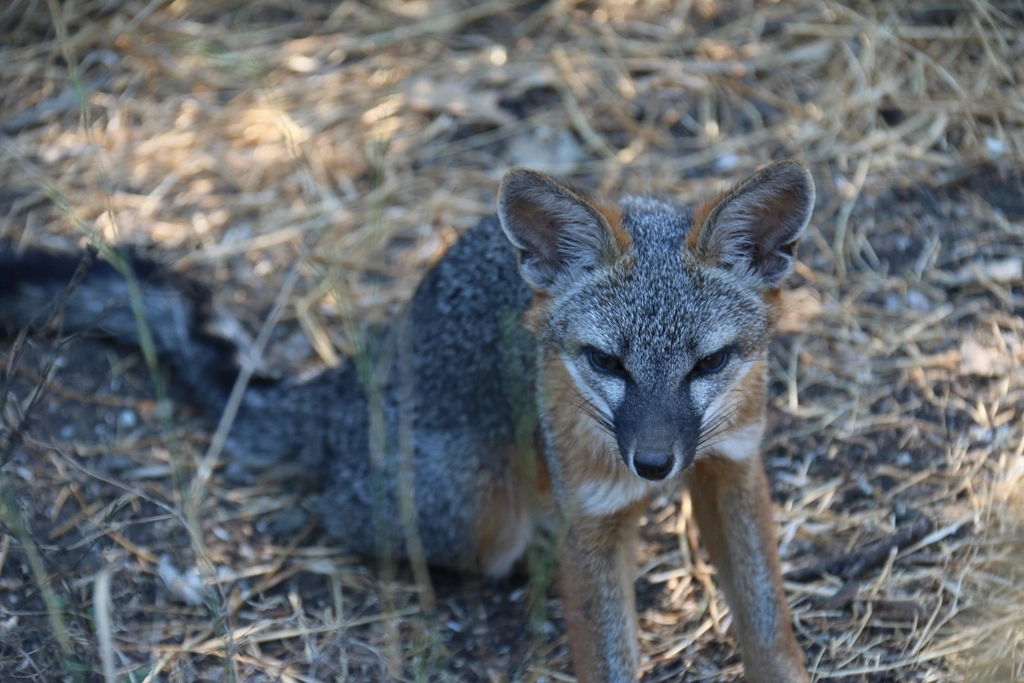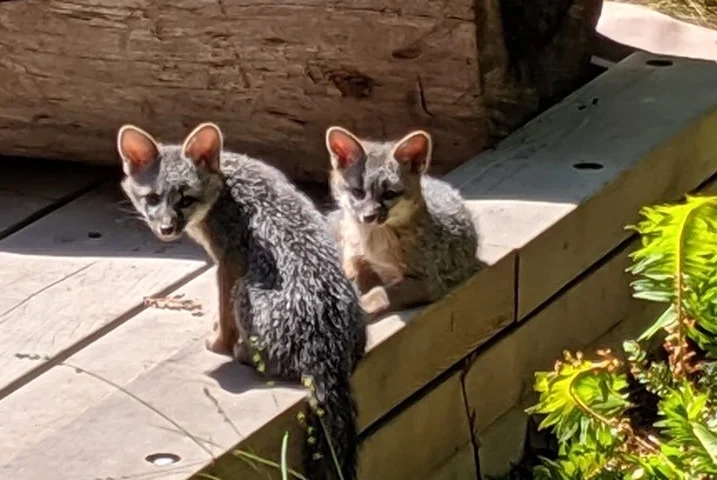Speculations On a Gray Fox’s Nose
by William C. Leikam
President, CEO & Co-founder, Urban Wildlife Research Project

On the backside of the Regional Water Quality Control Plant, Mama Bold and Papa Gray had their natal den tucked back and under the saltbush thicket. There Mama Bold had their litter of four pups one rain drenched night. About two weeks later, on one of my trail cameras, I came upon Papa Gray followed by those little balls of grey-black fur stumbling over twigs as they tried to keep up with their father. As the pups grew, I noticed those pudgy flat noses, year after year, and I saw those noses grow right on out into an impressive snout all within three to four months. By then they were halfway to maturity.
After seeing this time-and-again, I finally asked what’s going on here? Why do they grow that snout when indeed it might be more advantageous for them not to have that long snout sticking out there before their face? I’ll bet that there is a visual blind spot just like we humans. Why has evolution taken this course in the development of a gray fox pup – pudgy nose to long snout? Might it be that when the pup is born, having a pudgy nose makes it easier to be born and once they gain their eye sight, they can see much better than when they have that snout sticking out from their little faces?

I went in search of answers. There were none that I could find in the literature and so that led me into the realm of speculation. I began linking pieces together until I came upon a possible scenario.
According to the Cambridge Vet Care Animal Clinic, at birth and over their first 14 days of life, “…they are sensitive to touch, taste, and perhaps smell. Eyes and ears are closed and nonfunctional.” In short, they are deaf and blind. After about 10 – 12 days they can hear and see. With sight in place, it becomes visually easier to nurse and to find their way around. At this time in their lives, sight dominates because the face still sports that pudgy nose. When one of the adults drops off a delicious woodrat or squirrel or cottontail rabbit, they see it before they smell it. At approximately 4 weeks, its nose plays a minimal role in finding food.

By three months of age, their snout noticeably extends and develops. Their olfactory sense simultaneously matures until it clearly overtakes their sense of sight. Once this stage is reached, when sight is no longer used as much, smell and hearing begin to dominate and by the time that snout is mature their world becomes an auditory and olfactory universe of sound and smell.
Gray Foxes General Health
These two foxes appear to be in good health.
Total Numbers of Gray Foxes in the Palo Alto Baylands Nature Preserve
As of January, 2022, we have two adult gray foxes living in the Palo Alto Baylands Nature Preserve.
Section II
Update for the Urban Wildlife Research Project
Bill’s new book The Road to Fox Hollow has been released and can be found at Barnes & Noble Booksellers https://www.barnesandnoble.com/w/the-road-to-fox-hollow-wc-leikam/1140931306?ean=9781955690072 and directly from the publisher Di Angelo Publications at https://www.diangelopublications.com/books/the-road-to-fox-hollow. Dr. Marc Bekoff has an interview with Bill and that can be accessed at The Social and Emotional Lives of Urban Gray Foxes .
Bay Nature Magazine – How to be a Fox, the article about Bill and his ethological approach to his study of the gray fox is online here: https://baynature.org/article/how-to-be-a-fox/ Many are calling this a major article in the wildlife press.
BE SURE TO check out our YouTube Channel for some incredible wildlife videos at https://www.youtube.com/channel/UC5ujc7p8dU1-O5AbPAWz2_Q and our Facebook page.
LIVE & ONLINE Bill is schedule to make an online presesntation for the Mt. Diablo docents and rangers on March 16th. In addition, in April 2022 he will present at the Point Reyes Birding & Nature Festival. More on that coming up. He has an additional live event coming up also in April and on May 7th live at Safari West https://www.safariwest.com/ in the Elephant Room.
Undoubtedly the best Radio interview ever – KALW (PBS program Crosscurrents) – by Sofie Kodner during December 2020 – Broadcast 1/11/2021 5:00 PM. Check it out here https://www.kalw.org/post/bay-area-wildlife-habitats-are-disappearing-fox-guy-has-plan
You can access Bill’s PowerPoint presentation Corridors & Connections: Sustaining the Health of All Wildlife presented during the October 24th P-22 Urban Wildlife Festival here: https://www.youtube.com/watch?v=Dh4MQL1D1Cc
NEW – To find out more about us, search Urban Wildlife Research Project, UWRP, gray foxes, wildlife connection, linkages, corridors and several documentaries including the video clips.
Section III
Gray Fox, Baylands Goals
Within the permit that allows the Urban Wildlife Research Project to conduct its study of the behavior of the gray fox at the Palo Alto Baylands Nature Preserve, the objectives covered area:
- Monitoring of urban gray fox Denning sites in Palo Alto Baylands.
This is being accomplished during the period when the gray foxes use a den site. It is one of the prime locations for gathering most of the behavioral data of the litter and for adults alike.
- Assessment of status and population trends of Baylands urban gray foxes
Since January 2019 a pair of resident gray foxes have claimed territory at the Palo Alto Baylands Nature Preserve.
- Identification of habitat features that promote the presence of urban gray foxes
After considering this and talking with people who know how to restore habitats, we need to assess what kinds of plants, including the Alkaline Salt Bush, would grow best along the edge of the saltwater channel and alongside the marsh. We need to grow a permanent habitat that contains the corridors and plant it as soon as possible. We’ll keep an eye on this as this is a critical link between the southern region of the Baylands and the northern region.
- Assessment of reproductive success and identification of factors that promote successful reproduction
Open up the pinch-point along Matadero Creek by developing thickets that link one area to another, instead of the present “islands”.
- Identification and assessment of possible dispersal travel routes.
Presently there can only be guesses as to dispersal travel routes. We intend to make this important question much more concrete when we attain our collaring/take/capture permit from the Department of Fish & Wildlife.



